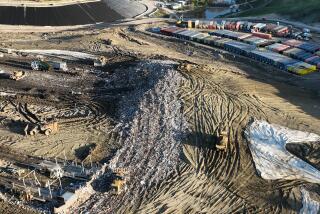Seepage, Odor Confound People Who Live Near Tar Pits
Most Los Angeles residents are aware that tar has been seeping up through the earth at the La Brea Tar Pits since prehistoric times, creating a rich fossil record that is now a major tourist attraction. What they don’t realize is that the thick, gooey muck is also a perennial source of irritation for many neighbors like Michael Daniels.
During heavy rains, tar regularly invades the elevator shaft of Daniels’ condominium complex on South Stanley Avenue, a half-block south of the Wilshire Boulevard tar pits. The sticky goo gives off a powerful odor and sometimes threatens to ooze into the elevator, creating a major headache for residents.
Last weekend, for the third consecutive year, residents enlisted their maintenance man to scoop the tar into 55-gallon drums, which collect in the building’s parking garage. The problem is that no one knows exactly what to do with the stuff.
Daniels said he’s gotten the runaround from city officials and received conflicting information from numerous public and private agencies. The last time residents hired a waste disposal company to haul the tar away it cost them $3,000.
“If you live here, you’re liable to get rid of it,” Daniels said. “The question is, what is our property and what isn’t? How far do you have to go underground before it stops being your property?”
When it comes to tar bubbling up out of the earth in the Miracle Mile district or anywhere else, the lawbooks offer little guidance.
“I wish I could give you one pat answer,” said James Langley, assistant director for the Bureau of Sanitation, which oversees sewage and storm drainage. “Generally, unless the property owner can show that it’s someone else’s responsibility, they’re pretty much stuck with it.”
Tar-related problems are nothing new in the neighborhood surrounding the tar pits and the adjacent Page Museum--a satellite of the county Natural History Museum--that showcases fossils recovered from the site. Tar has been known to seep onto nearby streets and parking lots and even to leak into storm drains. “It used to be that people would walk through the park and then walk through our galleries and track the tar on the floors,” said Keith McKeown, spokesman for the nearby Los Angeles County Museum of Art.
Oil/water separators are often used by neighborhood apartment buildings to keep oily ground water from seeping into underground parking garages. The filters then pump the clarified water into city storm drains.
The problem is that the leftover oil can’t be taken out with the trash. Buildings must pay disposal companies to pick up the oil and haul it to receiving facilities, where it’s refined and sometimes recycled for profit. The removal cost for property owners can be as high as $300 per barrel.
Just how hazardous is the tar? No one seems to have a straight answer.
“The state does not view it as being a toxic substance, but it is considered hazardous,” said Ed Santiago, an associate engineer with the California Division of Oil and Gas. “If you talk to the Fire Department, they might have a different view of it and the city might have a different view of it.”
Daniels wonders if the tar could pose long-term health hazards for residents of the building’s 12 units, particularly in light of the heavy fumes. But some might argue that residents should have known what they were getting into.
“It’s inherent in that part of the world,” said Bonnie Booth, a manager for DeMenno/Kerdoon, California’s largest oil recycler. “Common sense might dictate that I don’t want to live next to a tar pit. I don’t want to live across the street from Chevron, either.”
All the confusion has left Daniels exasperated.
“We’ve had this problem for a long time. People in our building get active about pursuing things, then rainy season ends and we say ‘Well, we made it through another year’ ”
More to Read
Sign up for Essential California
The most important California stories and recommendations in your inbox every morning.
You may occasionally receive promotional content from the Los Angeles Times.










